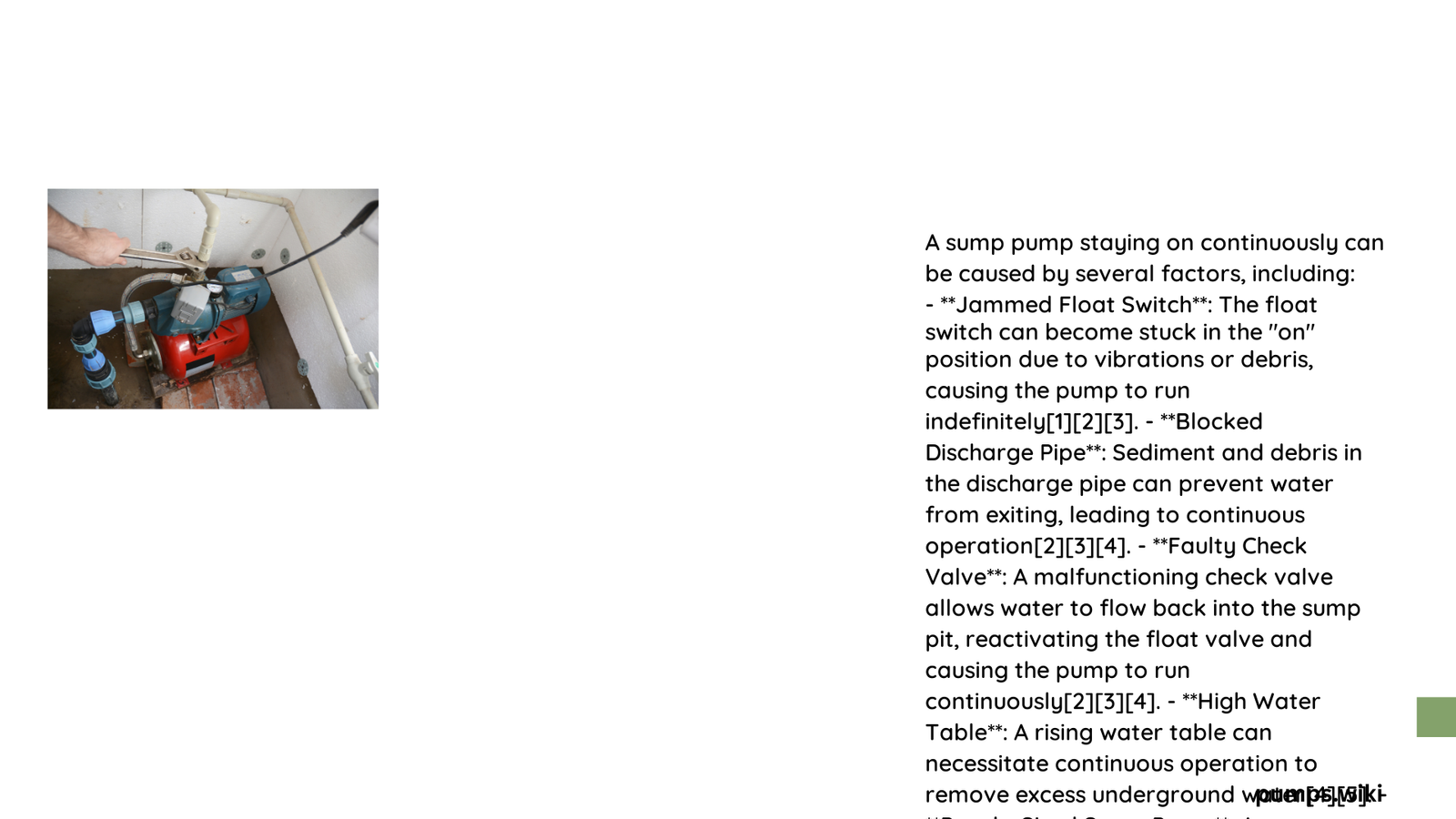A continuously running sump pump signals potential serious drainage issues that can lead to significant equipment damage, increased electricity costs, and potential basement flooding. Homeowners experiencing a sump pump staying on must understand the underlying causes, diagnostic methods, and immediate corrective actions to prevent long-term system failure and protect their property’s structural integrity.\n\n## What Causes Sump Pump to Stay Operational?\n\n### Why Does Float Switch Malfunction?\n\nFloat switches are critical components that control sump pump activation. When malfunctioning, they can cause continuous pump operation through several mechanisms:\n\n- Physical Obstruction: Switch trapped against pit walls\n- Mechanical Wear: Degraded switch mechanism\n- Electrical Failures: Faulty wiring connections\n\n### How to Diagnose Float Switch Problems?\n\n| Symptom | Potential Cause | Recommended Action |\n|———|—————-|——————–|\n| Constant Running | Stuck Float | Manually adjust or replace switch |\n| Intermittent Operation | Loose Connections | Check electrical connections |\n| No Pump Activation | Complete Switch Failure | Full switch replacement |\n\n### What Are Common External Water Drainage Issues?\n\nExternal factors significantly contribute to sump pump continuous operation:\n\n1. High Water Table: Persistent groundwater pressure\n2. Underground Leaks: Undetected water source near foundation\n3. Poor Landscape Grading: Improper water runoff management\n\n## Technical Diagnostic Strategies\n\n### How to Inspect Sump Pump System?\n\nProfessional diagnostic approaches include:\n\n- Measure water inflow rate\n- Check discharge pipe functionality\n- Evaluate check valve performance\n- Assess pit depth and pump capacity\n\n### What Maintenance Prevents Continuous Operation?\n\n- Regular Cleaning: Remove debris from pit\n- Annual Inspection: Professional system evaluation\n- Component Replacement: Proactive switch and valve maintenance\n\n## Economic and Structural Implications\n\n### What Are Risks of Continuous Sump Pump Operation?\n\n- Accelerated equipment wear\n- Increased electricity consumption\n- Potential basement water damage\n- Reduced pump lifespan\n\n### Cost Considerations\n\n| Repair Type | Estimated Cost | Complexity |\n|————|—————-|————|\n| Float Switch Replacement | $20 – $50 | Low |\n| Check Valve Repair | $75 – $200 | Medium |\n| Complete Pump Replacement | $500 – $1,500 | High |\n\n## Advanced Troubleshooting Techniques\n\n### How to Test Sump Pump Functionality?\n\n1. Manually trigger float switch\n2. Observe pump cycling behavior\n3. Check water discharge volume\n4. Measure electrical current draw\n\n### When Should Professional Help Be Sought?\n\n- Persistent operational issues\n- Complex electrical problems\n- Structural drainage complications\n- Repeated system failures\n\n## Preventative Recommendations\n\n- Install battery backup systems\n- Implement regular maintenance schedules\n- Monitor groundwater conditions\n- Invest in high-quality components\n\n### Final Technical Insights\n\nA sump pump staying on represents more than an operational inconvenience—it’s a critical system warning requiring immediate, strategic intervention. Homeowners must balance technical diagnostics with proactive maintenance to ensure long-term basement protection.\n\n### Reference:\n- Basement Waterproofing Experts\n- Plumbing Diagnostic Resources\n- Home Drainage Solutions

